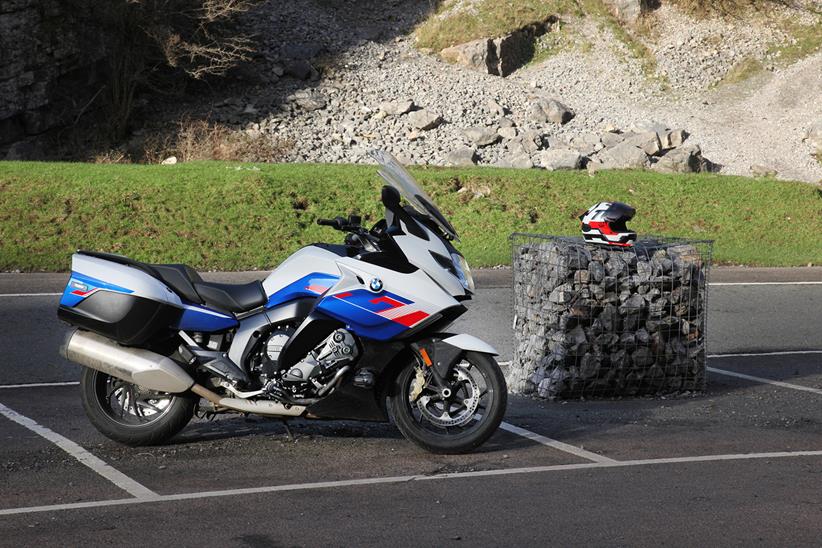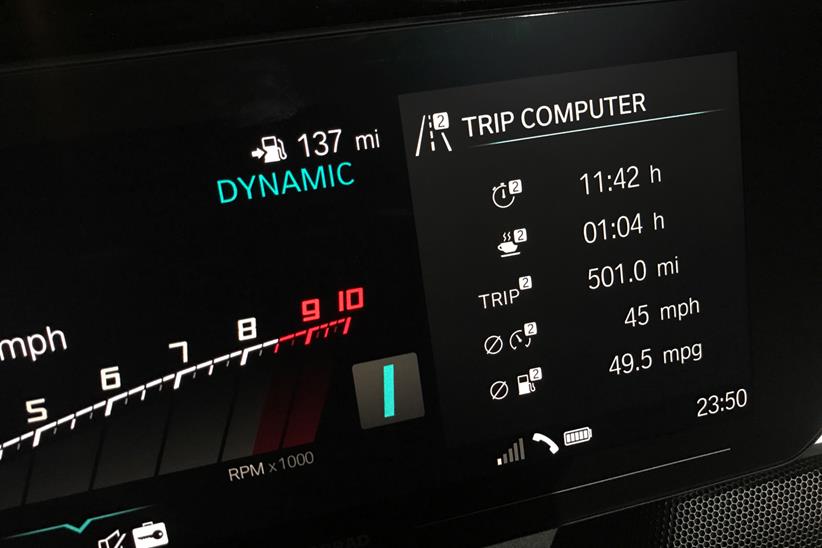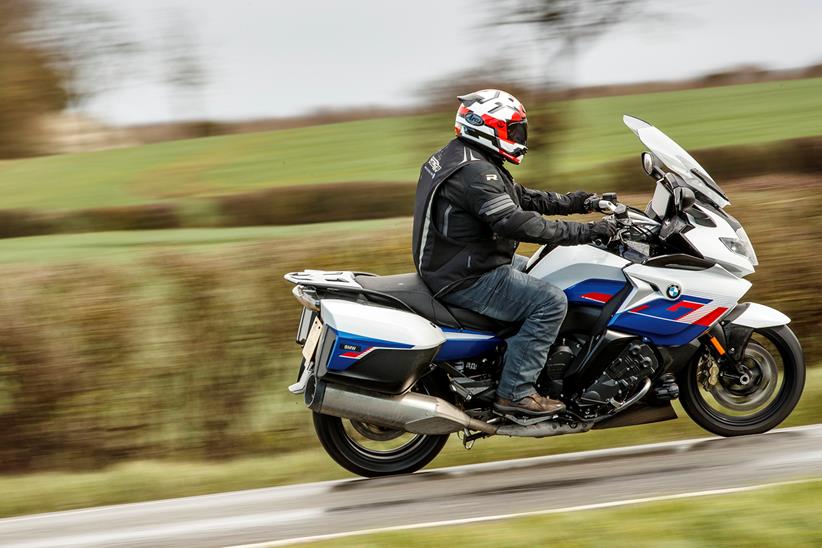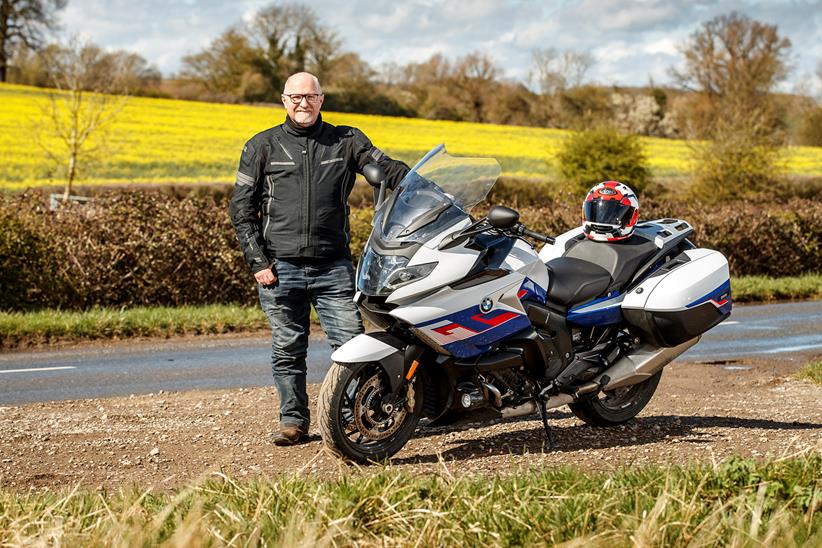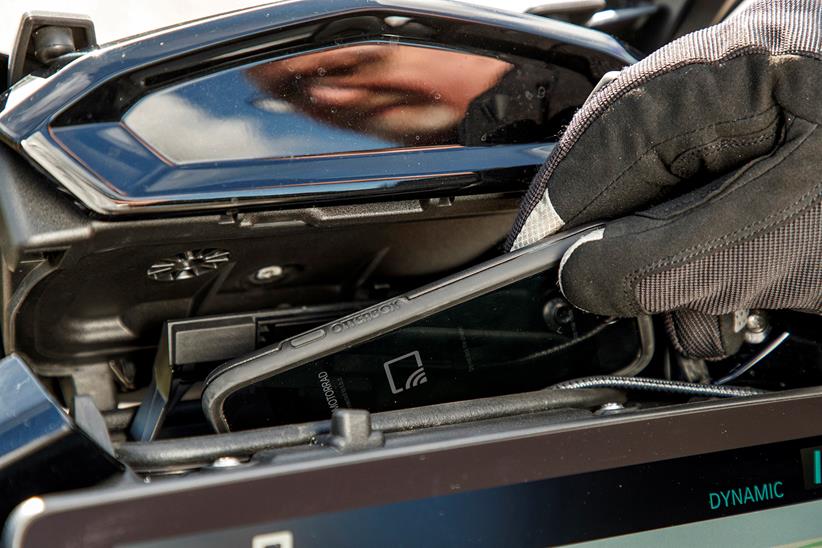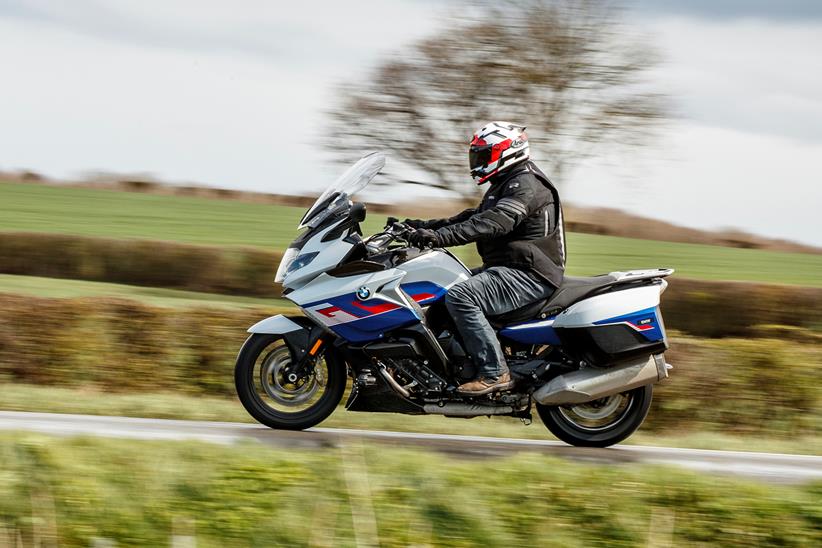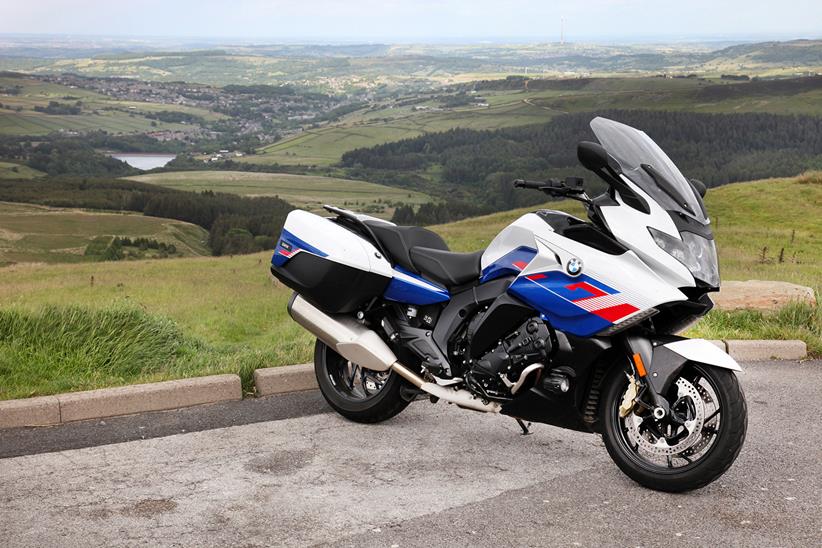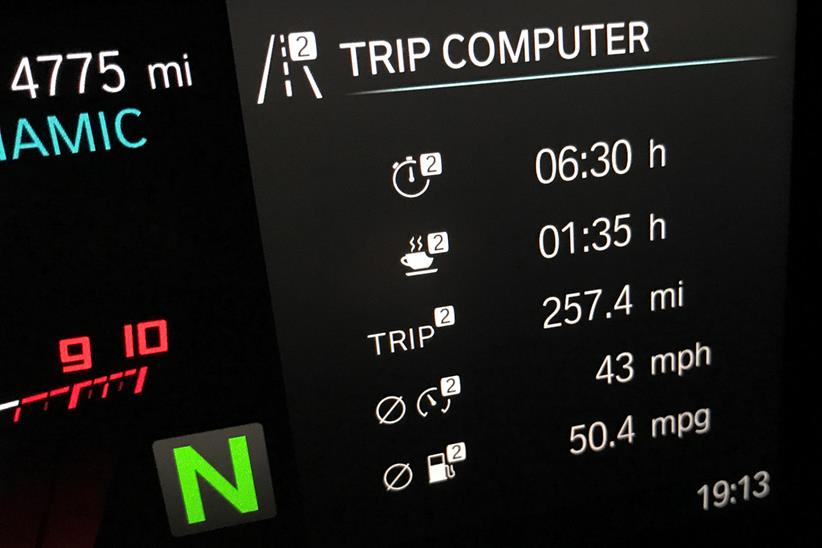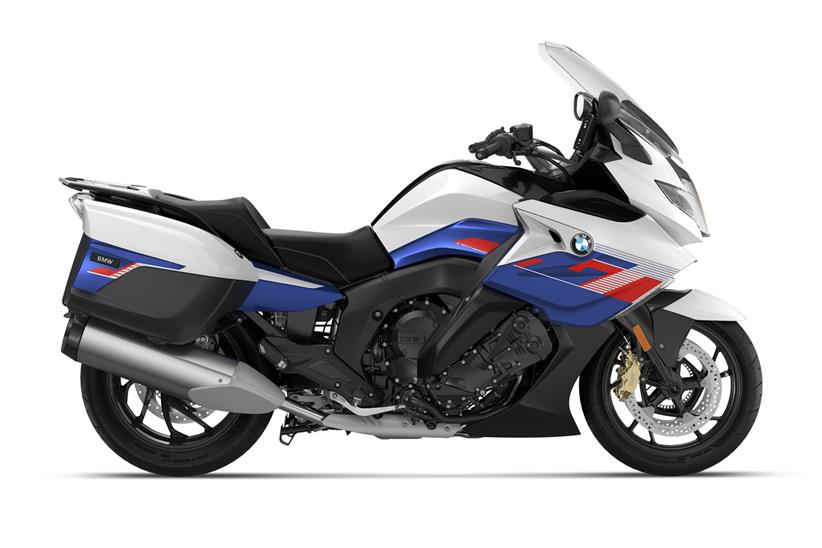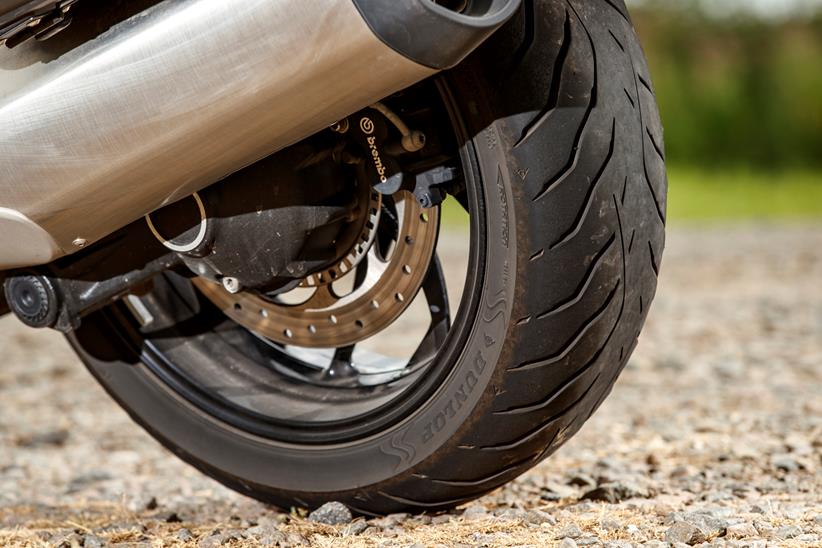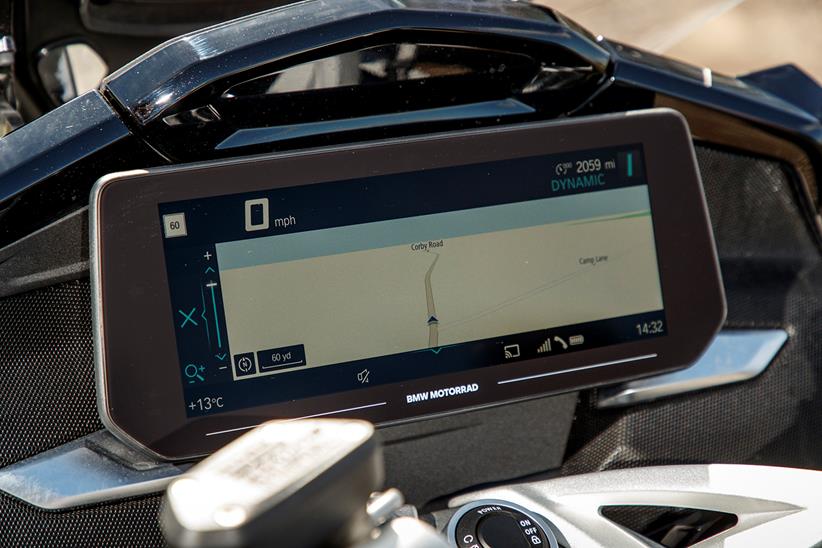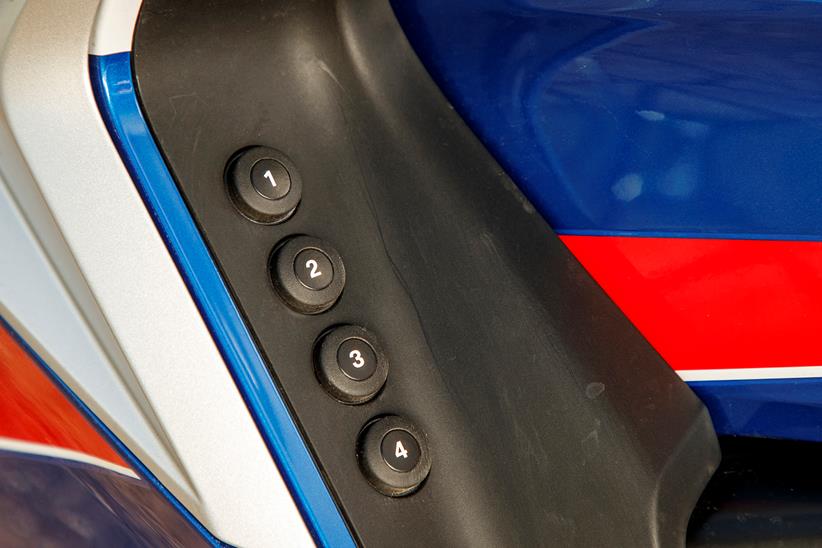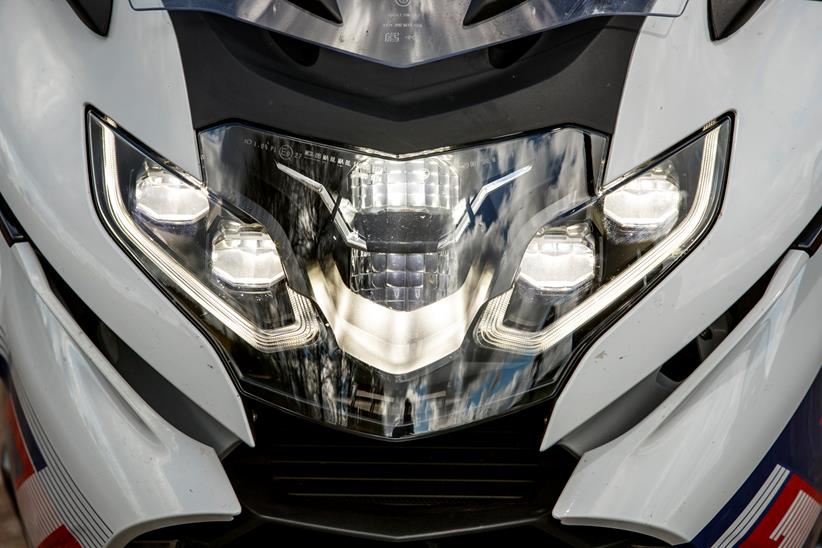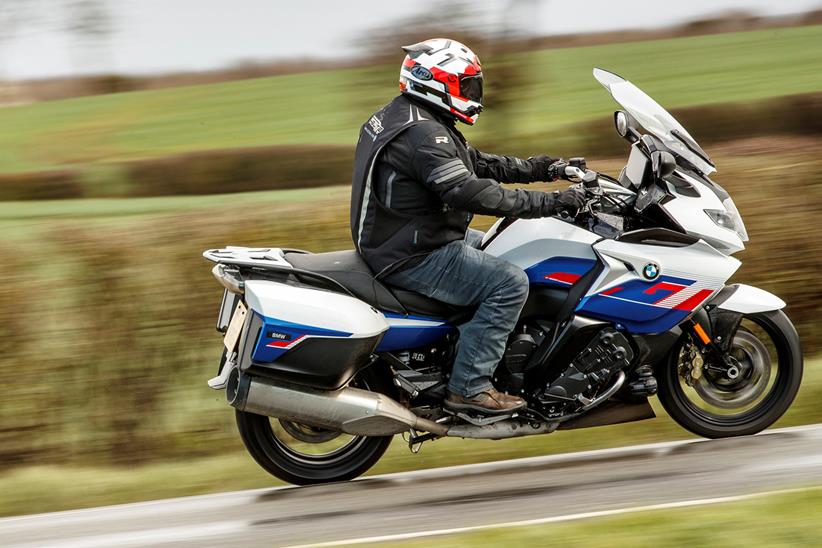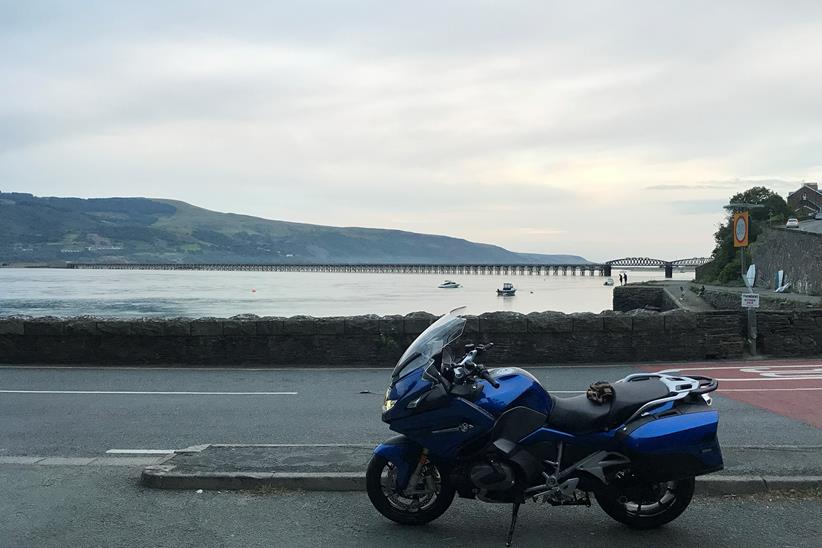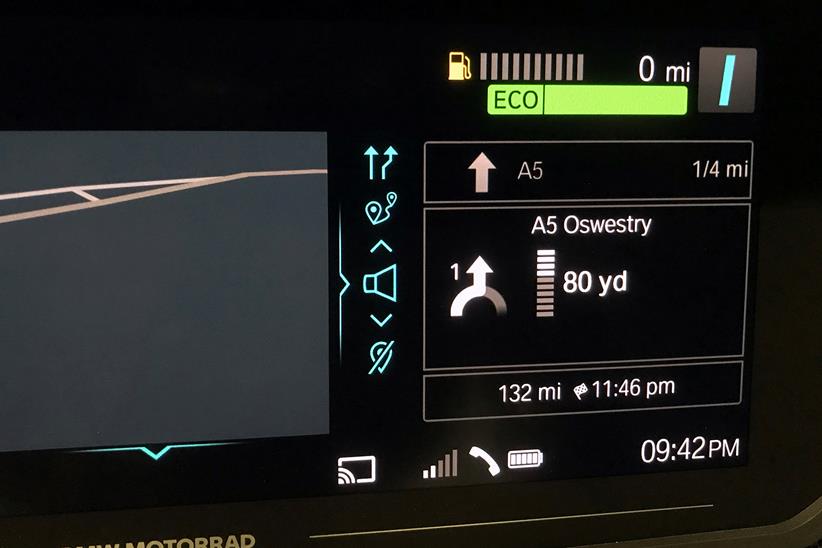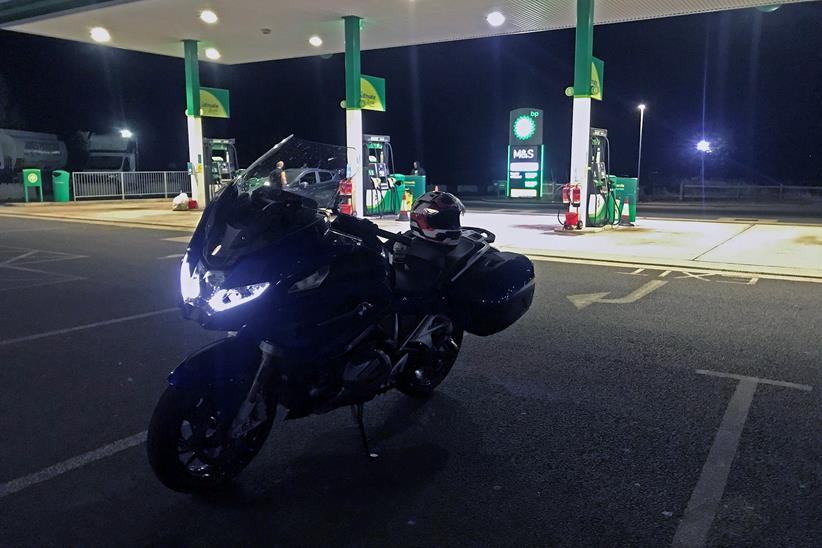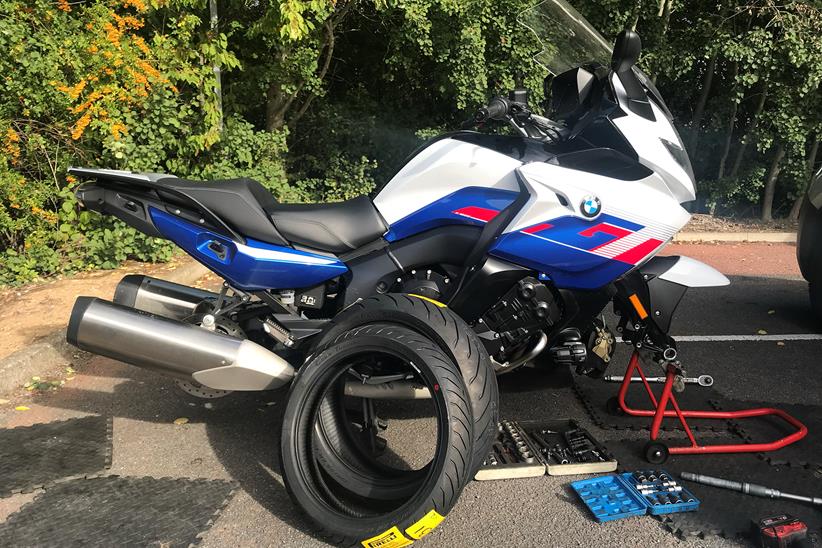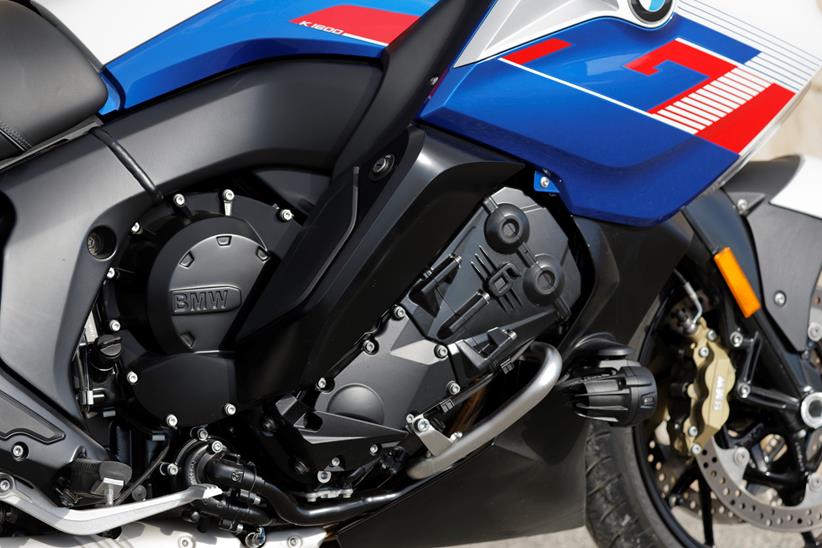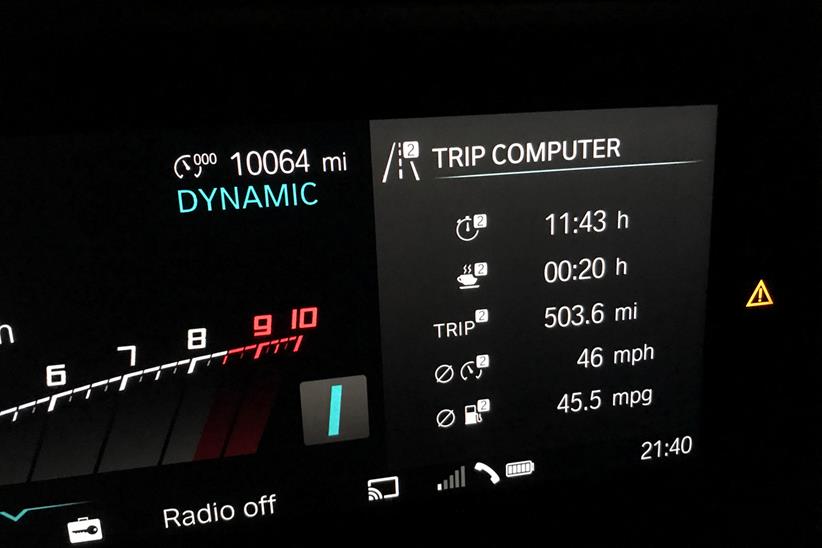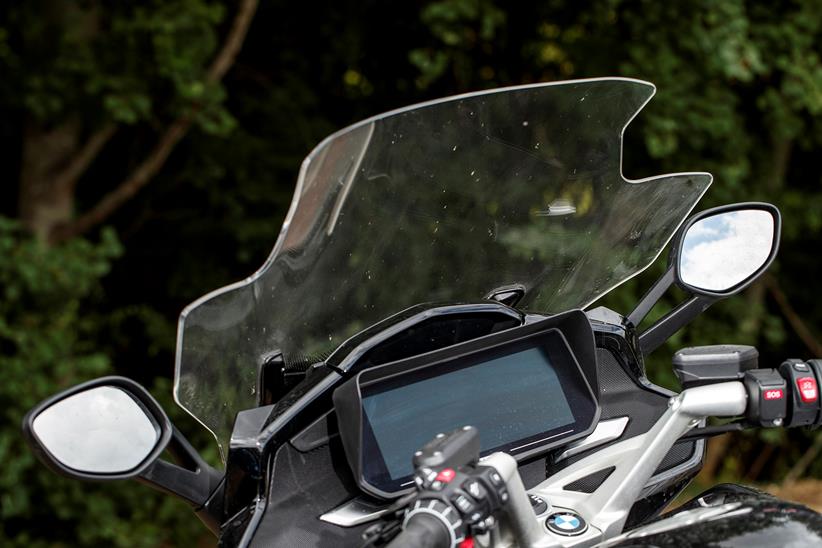MCN Fleet: Chasing five figures on the K1600GT through the elements
With the deadline looming for BMW’s monstrous K1600GT to make the pilgrimage back to HQ – and ultimately onwards to find a new owner – I had a couple of goals to hit, and just one day to achieve them.
The top one was to fulfil the promise I made to myself when the bike arrived – that I would get five figures on the odometer before handing it back. The other was the simple desire to nail another 500-mile day in the saddle, finishing my time with it in the same way that I’d started. In a moment of glorious celestial alignment, doing the second one would fulfil both goals.
‘Head North, no West…’
Having spent a chunk of time devising a route that would take me up from Stamford through the Dales and North Pennines before spitting me out over the border into Scotland for a quick tour of the Galloway Forest Park ahead of the plunge back South through The Lakes and the Peak District and back to home – I then checked the weather. And quickly changed my mind.
With gale-force winds and flooding on the menu to the North, and the weather looking less appalling to the West, I decided to slide down through Oxfordshire and the North Wessex Downs, crossing into the Mendips to cascade through Cheddar Gorge and then onwards over the top of Exmoor in time to hopefully see the sunset sizzle into the sea off the coast of Croyde.
Then, in the final dying embers of light, scythe across Dartmoor before resorting to the M5 and M4, and a diagonal cross-country dash home from Swindon.

‘503.6 miles later’
Some days, everything just gels and the miles slide by in a haze of concentration, enjoyment and fluid motion. This was one of them. Although there was a lot more ‘fluid’ than hoped for, with the sky dumping mercilessly as I cut across the top of Exmoor, slithering over cattle grids and clinging to the tarmac as the drop-offs to sea, gullies and river valleys tried to pull me into the void.
Despite an ambient temperature that never made it above 8°C all day, and 12hrs3mins elapsing between facing one way on my drive to then facing the other, there was nothing but comfort on offer. The GT’s excellent heated grips and seat played a part in that, while a KEIS heated jacket and gloves (J501RP and G701S) were the toasty icing on the cake.
The GT is a big bike to wrestle, and feels unwieldly and overbearing on tight, wet and debris-strewn roads – like Porlock Hill on this ride – but when the flowing is good, or you’re simply ticking off the miles on the motorway, it’s superb.

As the sun set behind an impenetrable bank of cloud and drizzle off the coast of Croyde (somewhat ruining my pay-off) I felt a long way from home, but the following 250 miles going the fast, rather than pretty, way home melted away as rapidly as the meagre heat that had warmed the middle of the day. All of a sudden I was home again, with 503.6 miles on the trip, and 10,064 miles on the odometer.
Anyone who’s done an Iron Butt (or loves big mileage days) will know that this was just a ‘half-day’, but many will baulk at the thought. Those people needn’t, especially on a bike like this. Apart from a smidgen on knee ache that required a couple of stretches on the final leg home past Silverstone, I felt as fresh putting the bike back in the garage as I had pulling it out twelve hours earlier.
Even if you don’t do it often – knowing you have that sort of capacity for distance at your disposal is a freeing and motivating power source. And if you start to tire, a few bursts of throttle dose you up again with wailing music from the inline-six masterpiece beneath you. The GT is by no means flawless – but it is a superb mileage hunter.
Update Eight: Winter wrapped-up as the weather turns Baltic on the BMW K1600GT
Published: 8 December 2022

On a hot day you’ll be reaching for the manually-deployable air scoops that open out from the fairing flanks to blast you with more airflow – but not at this time of year. Right now, you’ll really appreciate the BMW K1600GT’s cosseting barn-door of a frontal area that wraps you in a protective bubble and deflects the worst of the elements.
The broad coverage means that even those who suffer similar cake retention problems to me will be able to keep out of the windblast, while I find the saddle’s tendency to splay your legs outwards means that my knees and thighs are still a little exposed without conscious exertion to grip the tanks with my knees.
Any gaps around your sleeve/glove interface will also allow an icy blast up your arms as your forearms tend to be pretty horizontal. Your most exposed part is your feet – so good, waterproof winter boots are a must if you’re confronting the worst of the elements. Absolute extremities aside, though – you’re well protected from wind and rain.
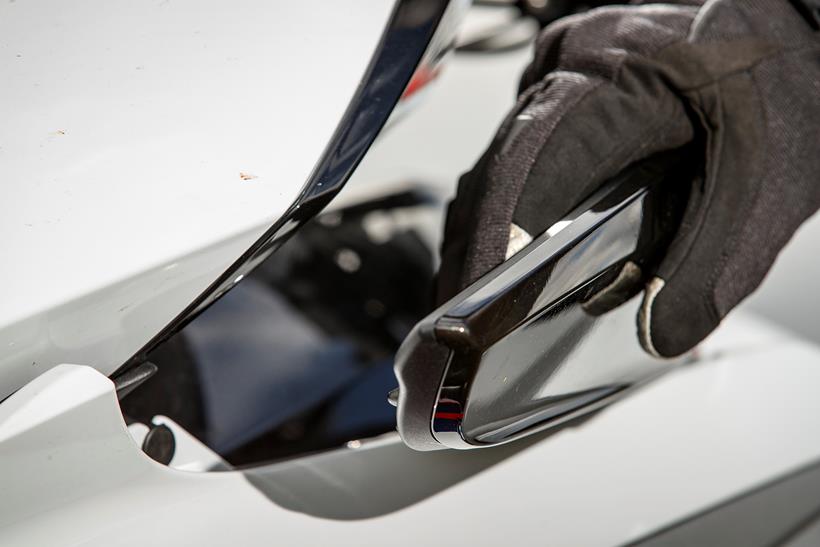
And while you’re happily evading the worse of the weather, there’s also the added benefit of some active heating. The highly effective 5-stage heated grips get properly nuclear, meaning I’ve so far been unable to sustain anything above level 3 (I have the heating menu linked to the shortcut buttons on the fairing for fast access).
Combined with Keis heated gloves – running from a harness to the battery, although there’s also two useful 12V sockets on board – on a low or mid setting, I tend to run the grips on 2 and can ride all day with very happy digits.
The heated seat takes a little longer to get going, and level 1 is undetectable by my ample posterior. Level 2 gives a gentle lack of coldness, while level 3 strays into active warmth, and 4 and 5 can get hot-coals enough to make you reach for the control wheel to dial it back down.
With big arteries taking the benefit, the seat does a good job of helping your legs and core to stay warm when the ambient temperature is unpleasantly sub-optimal. It also means that on dry cold days, I’m still wearing denim biker jeans instead of resorting to heavy winter textiles.
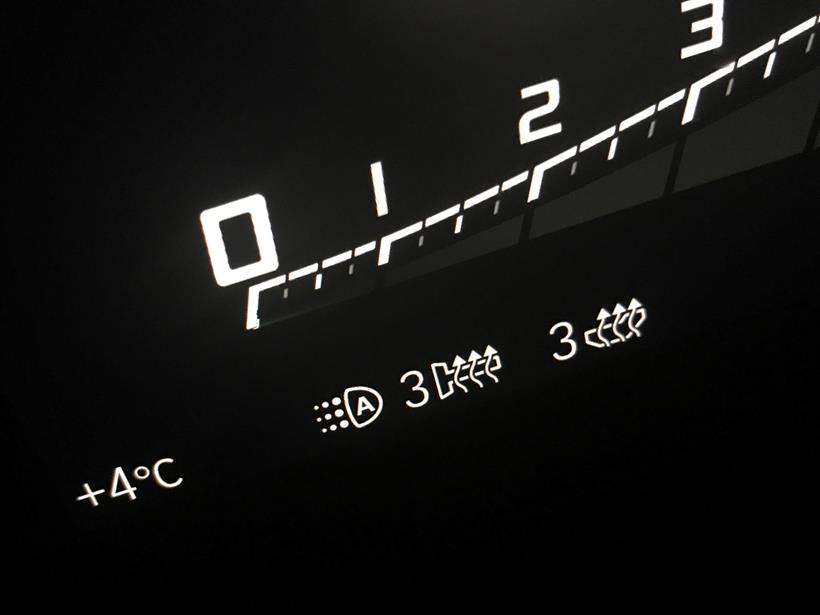
Feeling disconnected
While you might be languishing in the lap of luxury onboard – you won’t be completely comfortable with what you’re feeling through the broad handlebars. Warm, dry tarmac allows you to load the Hossack-style Duolever front-end with impressive aggression, when it delivers a feeling of great security and reasonable feel from the front-heavy GT.
But once the tarmac gets cold and greasy, you can’t get enough load (despite the weight) to really feel what’s going on. That leads to a glassy sensation that’s not aided by the GT’s propensity to sit up until you’re really encouraging it over, at which point it drops in fast thanks to the lolloping effect of 343kg + rider.
That mass also means you have to keep on top of your tyre pressures, and anything less than the recommended 42psi front and rear exacerbates the squirming sensation over cold tarmac.
But while the feel is slightly absent, it’s not manifested as a lack of grip from the front, although the relatively unloaded rear easily breaks traction on slimy and bumpy roads if you’re pushing on. Relax, and waft around with imperial grace, and it’s all perfectly civilised, if a little disconnected feeling.
Update Seven: How Fast is it Mister???
Published: 13 October 2022
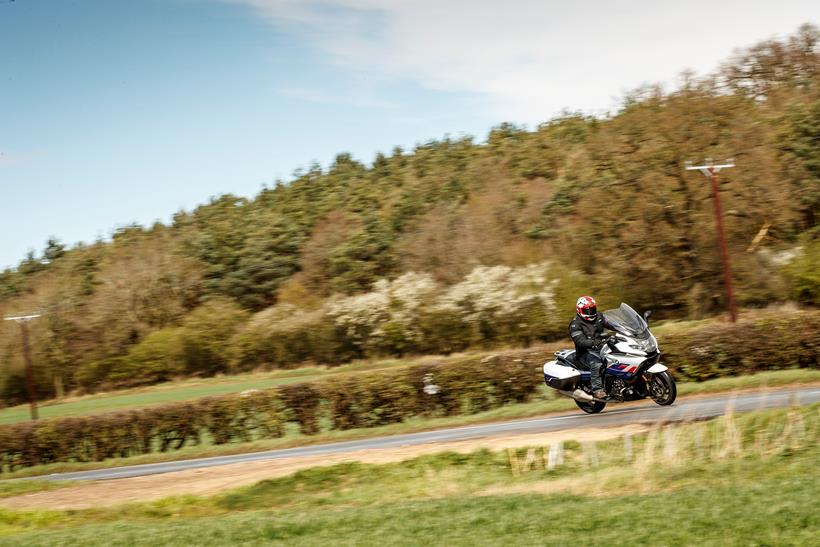
The BMW K1600GT inspires questions wherever I go, some from riders genuinely interesting in buying one, and many from those who are just wowed by its scale, that six-cylinder power plant, or the fact that it’s got a reverse button… Here are some of the most common things I’m asked.
‘How fast is it, mister?’
Well, top speed is rather irrelevant, but in terms of real-world useable speed (sticking below three figures on the expansive 10.25in dash) the GT is a pretty pokey beast. The 1649cc inline-six spins fast, and coupled with the quickshifter/blipper, it enables you to deploy a level of aggression under acceleration and braking that feels heavily at odds with the GT’s scale and mass.
It’s a quick bike. But despite the whopping torque (133lb.ft @ 5250rpm), the GT can feel oddly sluggish on overtakes in 4th/5th/6th gear – so quick passes on A and B-roads often require you to drop one or two cogs to give you the punch you’re expecting. Ride fairly passively and it’s a smooth and tractable bullet train, but be aware that you need to up your riding effort considerably if you want to make it dance and hustle.
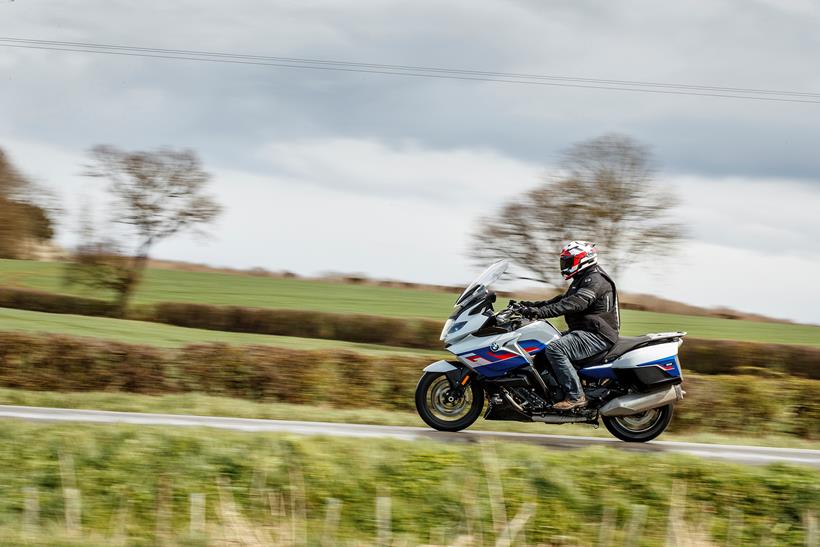
‘What’s the weather protection like?’
Bloody fantastic. Yes, it’s got acres of plastic to hide behind, but this isn’t always an accurate indication of how well the rider is cosseted. But the GT is brilliant when the weather gets all British on you. You stay remarkably well cocooned even in torrential downpours, to the extent that stopping during bad weather feels like a real assault as the protection of motion falls away. Ride from dry into a downpour and back out to dry again on a motorway, and you can emerge barely moistened. The wind protection is good in the dry, and there’s a big benefit there when it’s cold, too. The heated grips and seats are also highly effective.
‘Is the connect app any good?’
Yes, for what I use it for. I tend not to get overly excited about connectivity, beyond it enabling the satnav – which I use on almost every ride. The connection establishes relatively slowly on firm connection (but usually faultlessly), but then connects itself after short stops on a journey (like refuelling, for example) so long as you don’t lock your phone. The data available in the app on previous recorded rides is useful and fun (it records acceleration and braking G-force and lead angles), and I often look at it the night before going for a ride to see how much fuel I’ve got left and if my tyre pressures are ok.
‘What’s the best modification you’ve made?’
This is a toss up between two. First is the addition of a larger Wunderlich screen (£000) which utterly transformed the airflow from persistent noise and buffeting regardless of setting, to sublime calm and quiet. Second is running on sportier profiled rubber than standard fitment. I first switched to Dunlop RoadSmart IVs, which were fantastic, sharpened the steering and overall handling, and provided greater feedback and grip. Then I switched to Pirelli Angel GT IIs, which achieve the same trick, and are perhaps even more sure-footed when pushing on hard. If you change nothing else, a screen and tyre upgrade are transformative.
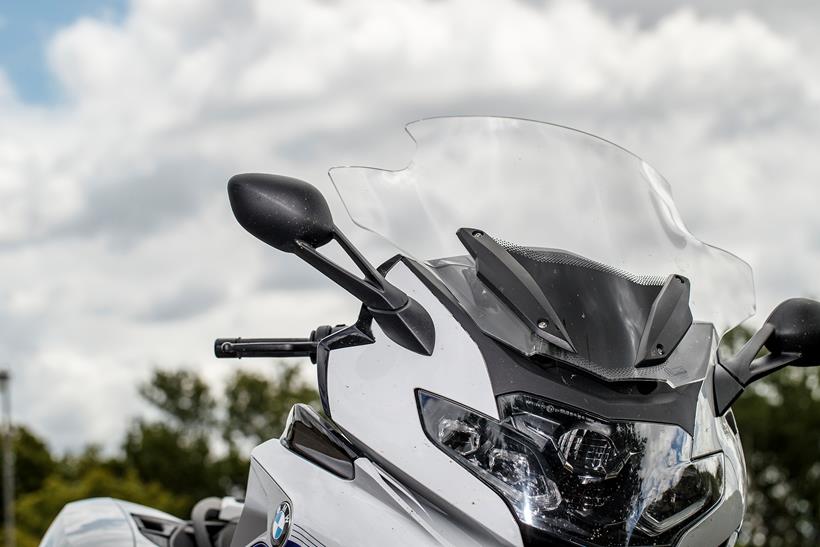
‘Are the panniers any good?’
Yes. And no. They’re a very good size, offering a total of 64 litres of stowage – and each pannier is the same shape as they sit about the twin silencers, rather than one side having to morph around an exhaust, as is often the case. You can get an XL full face helmet in each side, or more than enough clothes and paraphernalia to go on tour. They also boast central locking (along with the two small fairing cubbys by your knees) which is superbly useful, and can be locked from the bars or the key fob. What’s not so great is the lack of pannier lining bags, which – as they’re side-loaders – means all your junk spills out when you open them.
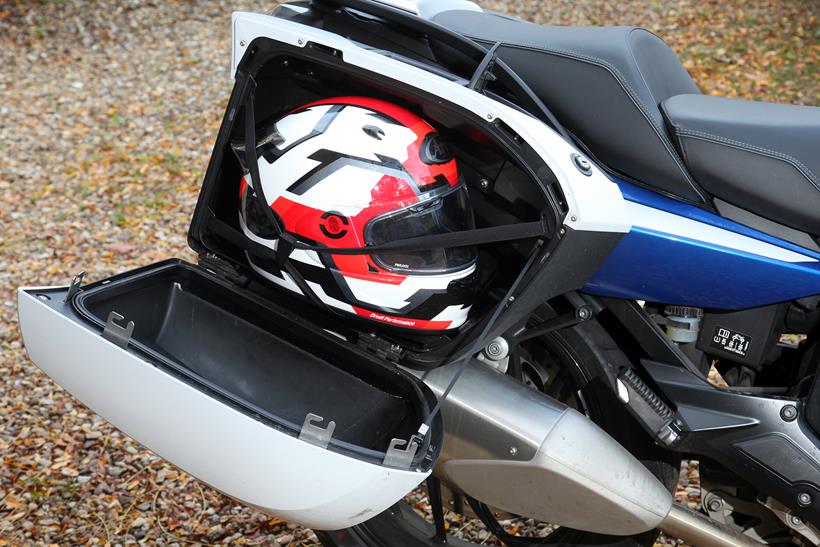
‘Do the ‘wings’ work?’
The wings are great in hot weather. If you’ve not spotted them before, the GT boasts manually deployable fairing scoops, designed to interrupt its usual slipperiness through the air, and force a direct air blast at the rider when battle high ambient riding conditions. They may not look large, but the effect is surprisingly significant. They do add a bit of noise, but the turbulence is below shoulder height, and the cooling effect of the airflow makes a big difference to your comfort levels.
Update Six: Trading Places for a Grand Tour
Published: 13 October 2022
BMW’s dominance of the tourer sales charts has all been thanks to one bike-the BMW R1250RT (and its various iterations of predecessor). With each update and evolution, the RT has moved, step-by-step, into an ever-more dynamic space – leaving the pipe-and-slippers image firmly in the past in the process.
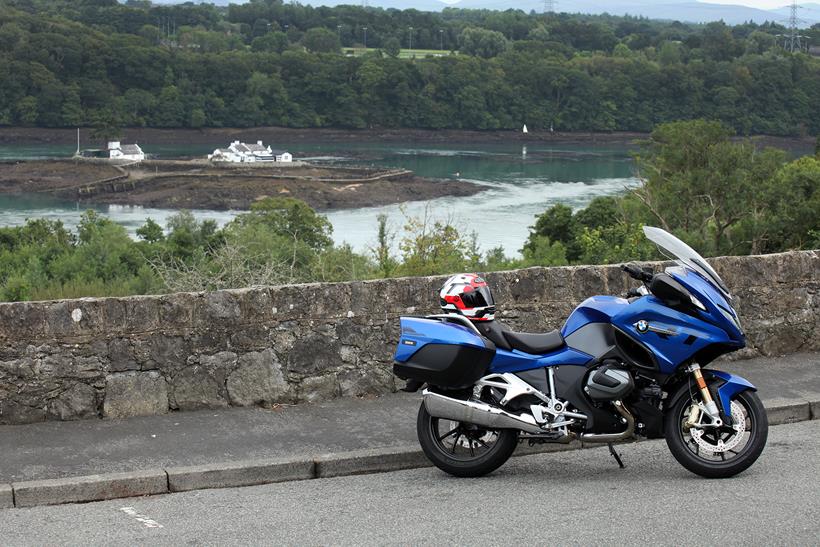
So, with my longterm test BMW K1600GT making a visit to the workshop for its scheduled service (due to mileage, not age) and a check-over, I took the opportunity to grab an RT for a week to see which touring leviathan suited my riding needs and style the best. Would they really be that different? Could the RT out-perform the K’s inline-six specialness?
At sixes and twos
There are numerous physical similarities between the two tourers: same dash, same panniers, same connectivity, switchgear, interfaces, attention to detail and quality touches. But there are tangible differences, too. While the RT is still a ‘big unit’, it feels tangibly more lithe and manageable than the GT – and that’s before you’ve even turned a wheel. The standover is slightly better (the seat itself is actually only 5mm lower), the bar-to-seat-to-pegs triangle feels instantly more natural (for my bulky 5ft11in frame) and simply bringing the bike upright off the side-stand instantly communicates the 64kg reduction in mass. Popping on the centre-stand is even more dramatic in terms of ease.
Once you’re rolling, the reduction in mass and the night-and-day difference between the inline-six and the boxer twin play havoc with your perception. The view from the riding seat, and all the controls, are so similar – but the riding experience is poles apart.
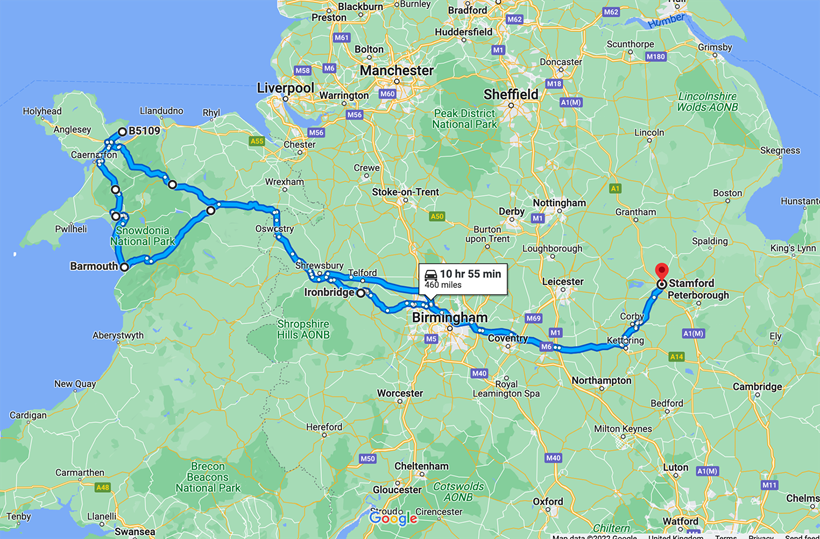
That reduction in mass is a critical part the RT’s brilliance. Short rides, long rides, spirited or sedate, having jettisoned the equivalent of a whole Marc Marquez from the equation the RT feels more engaging, more alive, and less tiring at all speeds in all conditions. In turn, it significantly boosts your riding enjoyment.
Then there’s the engines. The GT’s 1649cc inline-six is one of biking’s greatest engines – it’s sublime. Insanely smooth, fast-revving, torquey and powerful – it’s got it all. Well, almost. It’s let down by a clunky and agricultural feeling gearbox (regardless of using the clutch or the electronic two-way shift assist), which has an impact you feel all the way through the bike as it slaps the shaft drive and robs you of smoothness at the throttle. In its sweet spot, it’s sweet enough, but that’s high in the revs, riding it like a sportsbike. And a sportsbike, it ain’t.
By contrast, the RT’s drivetrain is beautifully smooth and compliant, allowing deft throttle inputs and gifting you a smoother ride at all points in the rev range. The 1254cc boxer is a far more sprightly lump, too – and with less mass to move it drives with cheeky verve right from the bottom end all the way to the redline. This is a fast and punchy tourer.
But if you want to really feel the cumulative difference, you need a decent ride. So, I knocked in one of my favourite Sunday afternoon blasts, from Stamford to Anglesey, then through Snowdonia to Barmouth, and home again. A 460-mile blur of motion and beautiful vistas. And – for me – the RT enriched the ride in every way. It’s more fun to ride, more comfortable, quieter (aerodynamically), more fuel efficient (by 10mpg), less tiring – without any negative concessions. It’s a big chunk of moolah cheaper (circa £4k on like-for-like specs), too.
Update Five: K1600GT dazzles and confounds in (near) equal measures
Published: 13 September 2022
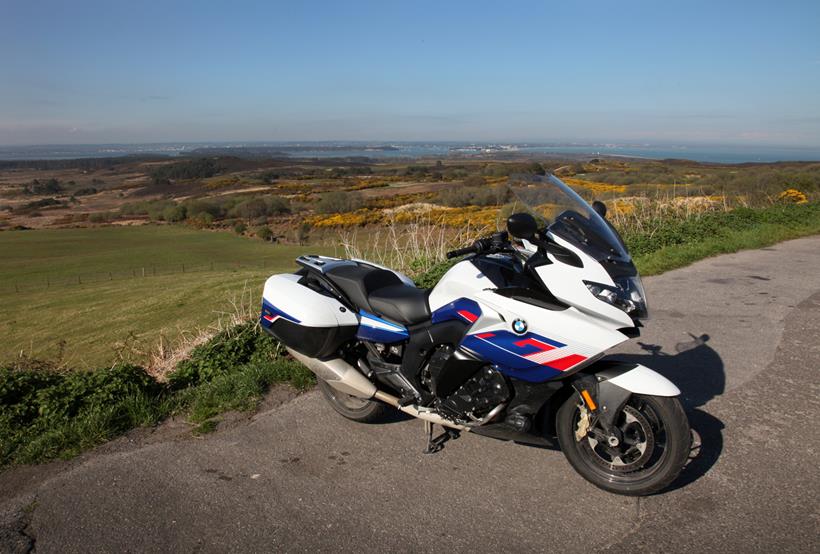
Before I started making a pedant’s diary of hits and misses about the BMW K1600GT, I penned a quick ‘preconceptions’ list, too – the idea being to create an interesting tick-box exercise in expectation busting enlightenment.
Perhaps the most interesting box would have been ‘Buy it? / Hand it back?’ I can count the number of long termers over the last 21 years that I didn’t want to keep at the end of the test on just my thumbs.
So, what about the K1600GT? I’ve not made up my mind, yet. The list of hits and misses has turned out rather too long for one update, so I’ve just pulled out three big ones of each for now.
Headlight – HIT
The gargantuan headlamp is a work of art. Not only does it boast all the usual DRL and auto-on functionality, but when the sun goes into hiding, the illumination from the Big K is enough to make owls and bats go back to bed.
The spread, clarity and intensity of the light is excellent, and with adaptive cornering functionality, the lights turn to look through corners as you do – rather than just illuminating auxiliary assistance. On a road full of S-bends it can leave you feeling a little drunk as the beam of light sways from left to right, but it’s effective.

Engine – HIT
What a glorious, wailing, snarling – but liquid-smooth – lump of inline-six brilliance. It’s a decadent offering in this day and age, and unlikely that another manufacturer will ever bother to package such a collection of pistons for a motorcycle again.
From the initial bark of start-up to its ability to pull in sixth at under 30mph, its hunger for revs when you want more power, and placid serenity when cruising, it’s brimming with unique loveliness. It does use a drop of oil though, 1800ml over the last 6500 miles.
Dash – HIT
The 10.25in TFT is pure bliss. No other bike’s dash feels as expansive (other than those that share it, like the R1250RT). I rarely use it in single-screen mode, almost always defaulting to the split screen option where you can have all the functionality of the primary display, but with a side-screen providing even more information.
For me, that’s usually the navigation window. Clear, easy to understand, vibrant, drowning in detail (with custom display settings available) and mainly driven by just one menu button and the rocking wheel – it’s impressive.
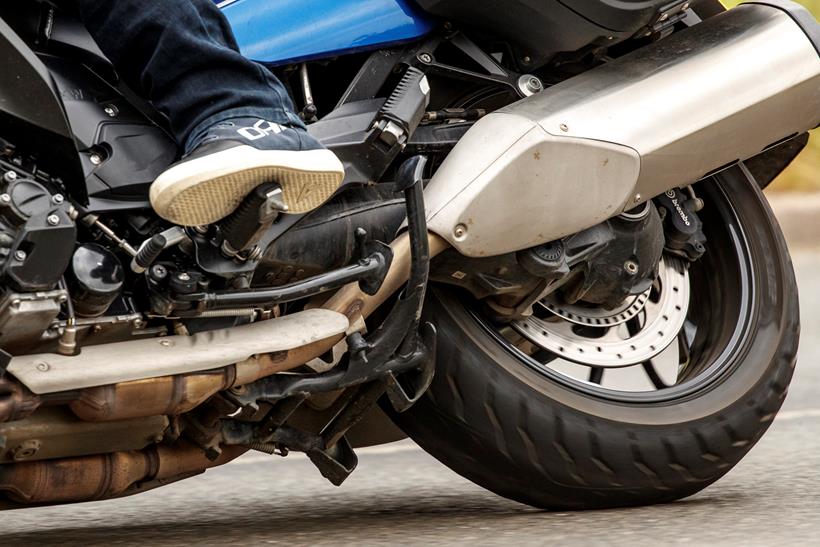
Shaft drive – MISS
Considering how silky that inline-six powerplant is, it’s a shame BMW have translated its output to the rear wheel via a driveshaft that would give Will Smith a run for his money at a slapping convention.
There’s nothing wrong with it on the throttle, or off the throttle, it’s the transitions between the two – and gearchanges – that cause winces of mechanical sympathy as it slaps with audible, thumping dissatisfaction. My GT is currently at BMW being serviced, so I’ve asked for the tolerances to be checked – but there’s a definite whiff of ‘they all do that, sir’ in the air.
Front end – MISS
I’ve always been a fan of BMW’s ‘funny front-ends’ – or, more specifically the Telelever. Yes, they take a bit of getting used to, but it really works. The Duolever on the K16 is less impressive. Perhaps it’s a symptom of the K’s astounding mass (which also bothers the rear’s Dynamic ESA in a way not seen on RT or BMW R1250GS), but the real shocker (see what I did there?) is the front-end.
While entirely composed, it crashes and slaps over bumps like a leaf-sprung cart and robs the GT of its otherwise plush and luxurious demeanour. Cue more wincing sympathy. Colleague Ben commented after a brief go on the GT that: “It finds bumps in roads that I’ve never found before.”
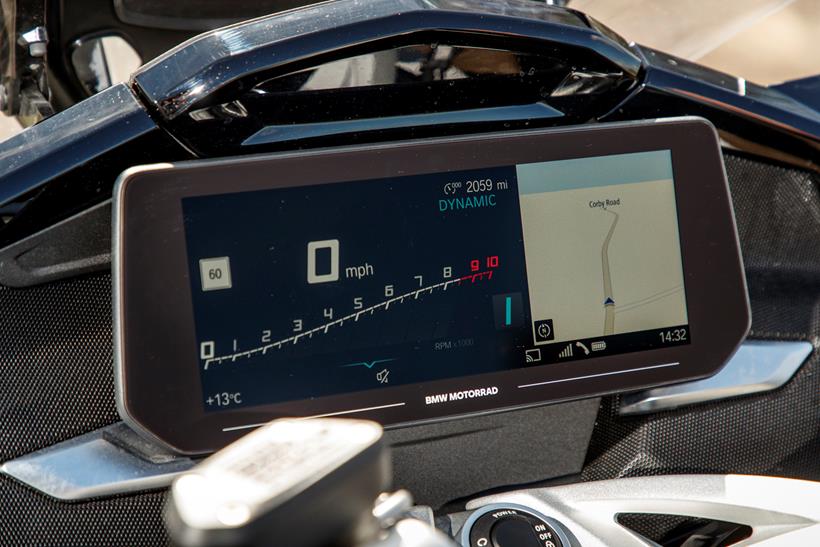
Weight – MISS
This is a massive super-tourer, so let’s not feign any surprise that it’s a weighty proposition. But what I can’t quite fathom is where all that 343kg of mass is hiding. Yes, it’s dimensionally big, and the engine is big lump – but the R1250RT is almost identical in scale, also boasts a big lump of engine, and yet weighs 64kg less!
And don’t think you won’t feel the difference – it’s not just noticeable, it’s transformative in terms of the ride and manual handling. If you’re wedded to the idea of buying a K1600GT for its luxury touring capabilities, I’d seriously urge you to try the BMW R1250RT for size – and weight – too.
Update Four: Time to release the K1600GT’s peg-scraping performance
Published: 22 July 2022
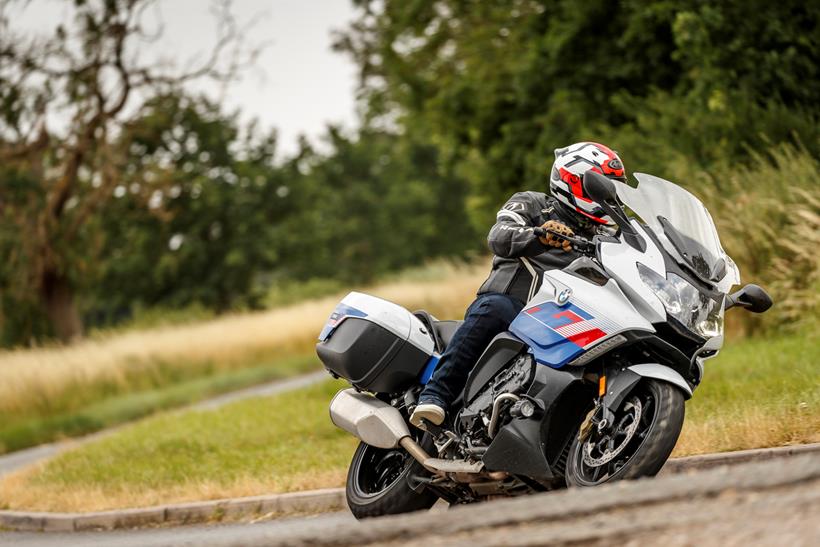
BMW’s K1600GT weighs a claimed 343kg. I weigh a claimed 75kg – but the truth is that I weigh 110kg – so by the time I’ve got a lock, my laptop and other daily detritus in the panniers, it’s a rolling 450kg. That’s a lot of mass to be squashing itself into the tarmac through a total small contact patch that’s smaller than your brain really wants to accept.
And the other forces at play are massive on the K16, too. There’s nothing shy about 159bhp, and the 133lb.ft torque is even more tyre-smearing. Then take into account that the BMW branded braking hardware (with a cameo from Brembo for the rear caliper) is seriously impressive –and you’ve got a recipe for getting through rubber that would rival a family planning clinic.
When the GT caught a nail in its rear OE Bridgestone at just 900miles, I decided to switch rubber to something else. Not because the T30 isn’t a good tyre (it’s a very good tyre), but because I thought the GT ought to steer better than it did, and speculated that the T30 could be the culprit. It was.

With a set of Dunlop’s new-this-year RoadSmart IV GTs fitted, the K16 was transformed from ocean liner to motor yacht instantly. Turn-in, mid-corner precision and feel (front and rear) and drive on exit all improved tangibly. Don’t get me wrong, the K’s Paralever/Duolever suspension will still feel odd to the uninitiated, but the right rubber really releases the GT’s peg-scraping performance.
Interestingly, the front/rear balance in terms of how much of the tyre the GT uses is almost identical – with the pegs brushing the road while leaving 10mm of virgin rubber front and rear (usually there’s a disparity). Incidentally, pegs down comes at 45-degrees of lean, according to the ride data available through the connected app.
So how has that performance changed over the last 5038 miles? Well, it hasn’t. The RoadSmarts have been remarkably consistent as wear increases, and only now can you feel the tell-tale signs of a squaring rear tyre.
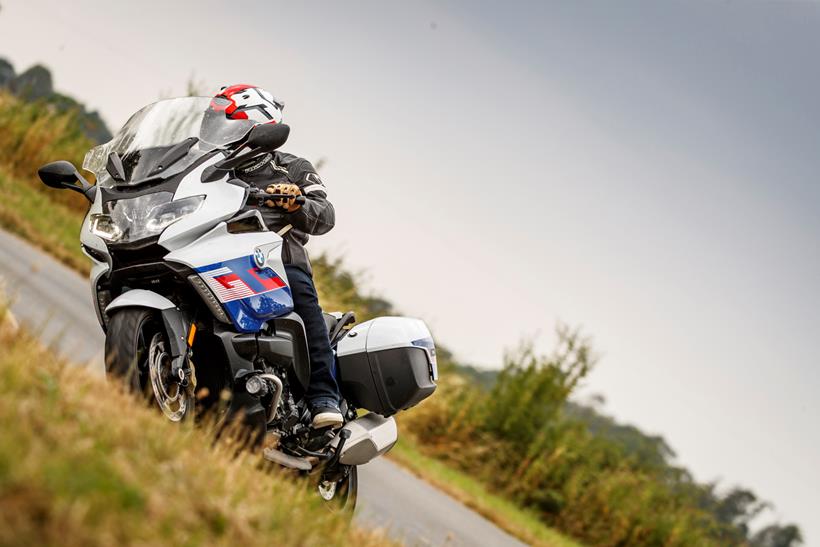
It’s most noticeable in the wet, when you’re cornering more progressively, and tend not to use so much lean, meaning you’re dancing around the square edge more. In the dry it’s almost imperceptible Nonetheless, I’d guess the rear could usefully tolerate another 1500 miles of enthusiastic use, the front a little more. But I’ll be switching imminently to test Pirelli’s Angel GTs.
Talking of the wet – the RoadSmart IVs perform brilliantly. Their inherent near-instantaneous warm-up means ready confidence from the off, and you’re unlikely to find you’re any slower from A to B in the wet that you are in the dry. The only times I’ve had momentary heart-flutter of feeling unconnected to the front tyre has been on greasy roundabouts after a long period of dry is followed by a deluge – but I believe the Duolever is the more likely culprit for the reduction in feel at the bars.
A damn fine tyre, which makes the GT’s damn fine skills even finer.
Update Three: K1600GT poses the question of nature or nurture
Published: 27June 2022

I’ve got absolutely no idea where I am. There’s a snaking blue line on the dash, revealing the rolling, constantly unfurling, next section of tarmac-clad entertainment through the hills, but beyond that fallback assistance and my accurate inbuilt compass letting me know which direction is home – I’m lost. And it’s bliss.
This doesn’t look familiar
I’m somewhere in the Peak District (I’ll look at the route trace on the BMW Connected app when I get home so I can see where I went), and I’m deliberately hopping between places I know, on roads that I don’t. So apart from momentary ‘oh, I’m here’ revelations as I reach known locations from unknown angles, the mantra for the day is firmly ‘this doesn’t look familiar’.
The mentally freeing effect of being happily lost without a destination or timescale to be concerned by means my brain’s been wandering as much as my wheels have – and it resurfaced a question that, while simple enough, I find oddly beguiling. Would I be doing this if I wasn’t on a touring bike?
Horses for courses
My garage is full of sportsbikes – and so are the Peak District’s roads, most likely piloted by locals surging in from Manchester, Sheffield and the surrounding area – all seemingly lap-time-motivated rather than being interested in the landscape. But would I have schlepped a few hours up north on my Ducati 996, Honda SP2 or Suzuki GSX-R750 just to tank around the Peaks’ lanes for a few hours? No, probably not. I’d have come on my VFR, though.
I’m more than happy to tour Europe-wide on a sportsbike, but exploring, getting lost on purpose, navigating unknown roads and bumbling about nosing over hedgerows feels much more natural on the big BMW K1600GT. Inherently more comfortable, too. So, I’m only here because of the type of bike I’m riding.
The right tools
On any normal sunny weekend, there’s no doubt my heart is still most sated by tanking around on something poised and purposeful – but I think two years of pandemic disruption have given me a split personality. Increasing wanderlust makes me want to see new places, discover new roads, fill my brain with images I’ve not seen myriad times before – and the GT is bloody brilliant for the task.
Not faultless, though. It’s the right tool for the job, but not without its frustrations.
Not entirely Appy
I’ve reported before on the superb 10.25in dash the GT is fitted with, and the huge array of inbuilt and connected app options that turn it into a true multi-media one-stop shop. But there are glitches. The most frustrating one is with the app’s mapping interface. When it’s working perfectly, it’s fantastic, but the map regularly confuses itself and seems often incapable (sometime for long periods) to be able to hold onto the location accurately.
This means the screen thinks you’ve ploughing fields, going the wrong way, riding an adjacent road, or just utterly lost. It eventually locks back onto your location and direction of travel, but it can take miles, and happens repeatedly – sometime leaving you stranded at junctions without the foggiest idea which way to turn. The drops outs don’t even appear to be driven by mobile signal coverage.
While I’m moaning, the radio reception (both DAB and FM) is pretty awful, too. Thankfully, all the other functionality has been flawless.
Service and protect
With close to 5000 miles on the clock, I’m rapidly approaching the next service marker (1800 miles to go – so another 4-6 weeks at the very most) – and there are two things I’ll be asking the technician to look at. The shaftdrive feels surprisingly clunky to me, so I’d like assurance it’s within tolerance, and the bi-directional quickshifter is also not performing as well as other K16s I’ve ridden, so perhaps a software update is needed.
A reader contacted me the other day to say his K16 is burning a 500ml of oil every 1000 miles, prompting me to spend a long time carefully going through the laborious oil checking process. After 4500 miles of use, the GT needed 350ml of oil to get it to the max line. But I didn’t check it when I took delivery (doh), so I can only assume it was brimmed at that point and has used the 350ml since. I’ll keep an eye on it and report back.
All very tyring
The GT comes on Bridgestone T30s as stock. Great tyres they are too, but they do suit some bikes more than others, and I didn’t like the way they made the GT steer (lazy turn-in, then it falls on its ear like you’ve hit diesel). So when I caught a nail in the rear at 900 miles I switched to Dunlop’s new RoadSmart IVs. They’re superb. They suit the GT well, cured the steering oddness immediately, and after exactly 4000 hard-riding miles, they’re holding up beautifully. Full report on them next time.
Update Two: Rich puts in a 501-mile day on the BMW K1600GT
Published: 20 May 2022
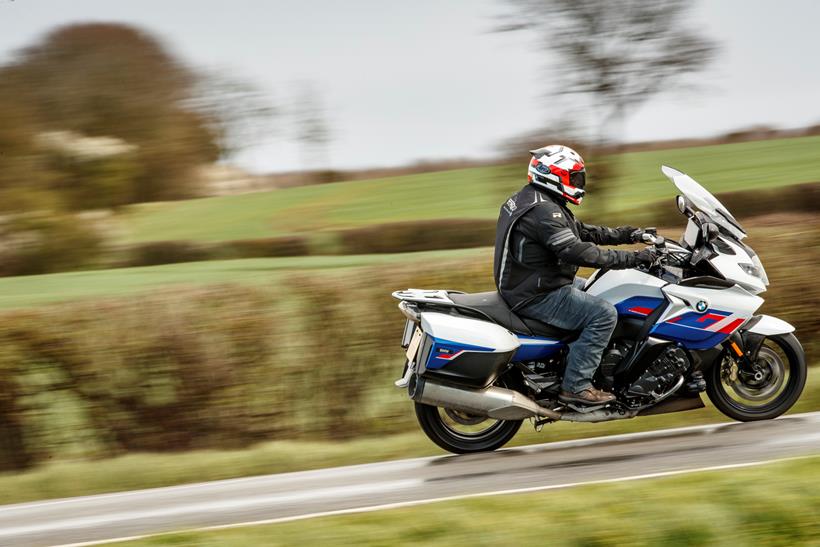
The Proclaimers might have been perfectly happy to perambulate 500-miles on multiple occasions, but I much prefer to employ an engine and two wheels in my travel assignments. And with the prospect of a sunny day and nowt else of more import to distract me, I devised a 500-mile loop to hit a few favourite roads and key destinations in order to see how the big K stands up to persistent mile-munching.
From my Stamford base I headed West over to the Cotswolds, then plunged Southish down through Bath and Shaftesbury and onwards to Corfe Castle, Swanage, over the ferry to Sandbanks, then up to Winchester to wiggle East on the A272 before heading North for a cuppa with my Dad in Kent, and finally resorting to big roads for the last leg towards home. 501 miles, 11hrs42mins in the saddle, averaging 45mph and 49.5mpg revealed a few observations…
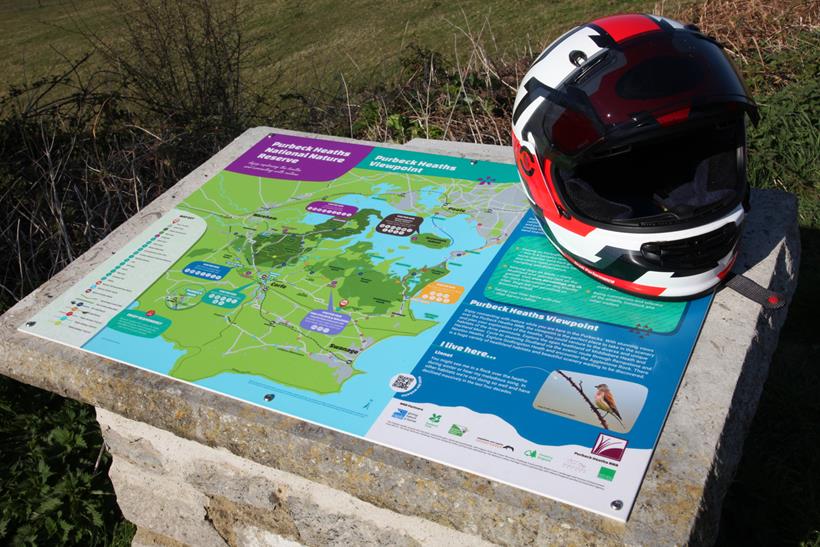
Firstly, the BMW K1600GT is defined by a vitriolic pursuit of trying to give you whatever you want, whenever you want it. It may be a big old boat, but it never gets in the way of your ride. If you want to stop, it’s because you’re ready to stop – not because the bike has motivated you to.
Some bikes hurt you after an hour or two, the K doesn’t. After about eight hours I was getting oddly stiff knees and thigh muscles – but all the other usual pain points (hands, wrists, bum, feet, back, neck…) were all no more abused than they would be after fifteen minutes settling into your sofa.
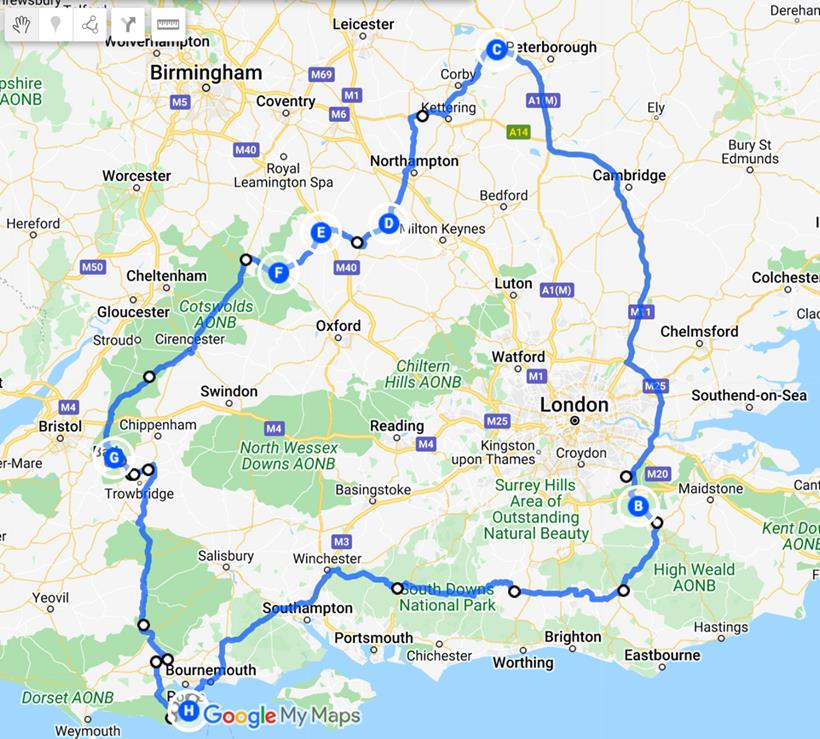
You do settle into the K, too. The more the miles increase, the more you feel at one with its rhythms, finding the sweetspots in the engine, gelling with the flow of its mass transfer as you throw it around on sinuous roads.
The engine is your cheeky mate along for the ride, keeping you entertained, amusing you with its chat, and keeping you sharp and focussed. It may boast close to 160bhp and diesel train levels of torque, but it never dominates the ride. It’s like double cream with a shot of whiskey in it – sickeningly smooth with a tingling punch of menace.
The Dynamic ESA isn’t quite as effortlessly composed as it is on the RT and GS – the sheer gargantuan mass of the GT (the weight of an average human adult more than either) giving it much more to cope with – but it’s still excellent, if not quite faultless. The screen is definitely a bit of a let-down though, and always has been on the GT.
In a low position it’s like sitting in a wind tunnel, at full extension the vortex pushes you forwards like a grumpy pillion, and at infinite degrees of somewhere-in-the-middle it never seems to be quite where you want it. Time to experiment on that front.
Previous updates:
- Update One: BMW’s K1600GT is a bonkers inline-six behemoth
Update One: BMW’s K1600GT is a bonkers inline-six behemoth
Published: 18 May 2022
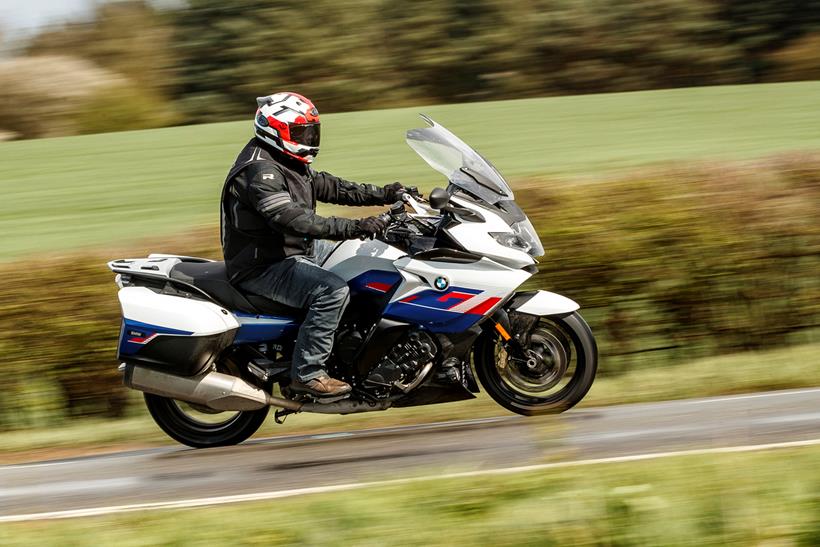
If you’ve got a bucket list of roads and regions that you’d love to ride on two wheels, it should include the roads around Franschhoek and Chapmans Peak Drive, which hugs the ocean from (you guessed it) Chapman’s Peak to Capetown, South Africa. Just stunning. And it was on these roads that I first sampled BMW’s insane super-tourer, the K1600GT. It was the original bike’s launch, now over a decade ago – and the big GT feels no less exceptional today, especially when confined by British roads.
This is the first dedicated touring bike I’ve ever ‘lived with’, and the physically biggest, heaviest, and largest capacity, too. It’s also the only inline-six. So, after 10,000 miles on Ducati’s superb Multistrada V4S last year – what are the immediate impressions of the Special K after 2000 miles of road-rolling?
Silky smooth operator
It’s impossible for the whole riding experience not to be dominated – defined, in fact – by the 1649cc inline-six that powers it. From the rasping bark that’s emitted every time you thumb the starter, to the silky seamless drive that surges, soars and screams as the revs built, it’s an incredible unit. A sick part of me would love to shove this surprisingly compact lump into a super-naked. The torque is exceptional, the drive is turbine-like, and it’s just so, so smooth. It doesn’t feel aggressively fast, but the rate at which the horizon approaches, and other road users shrink in your mirrors gives context to its pace. If the K didn’t weigh so much, it’d be ballistic.
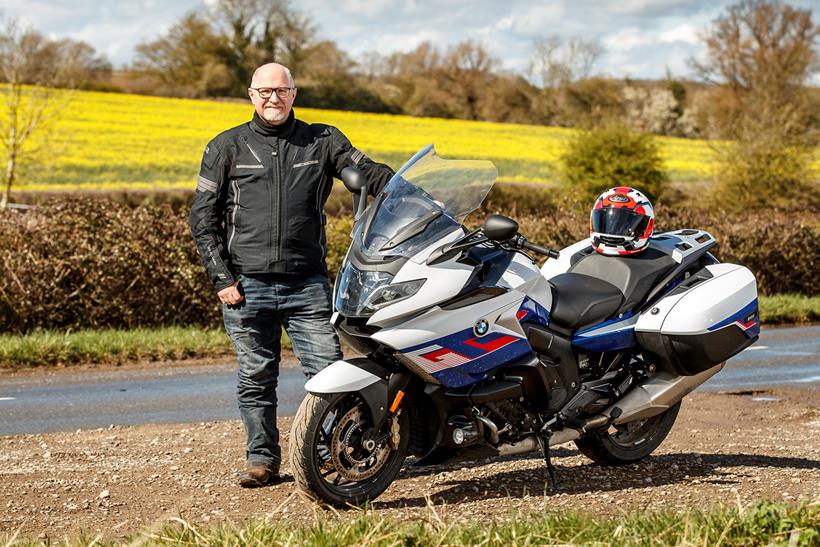
Widescreen TV (and radio)
The Multi has a class-leading dash, effortless access to info, and a tidy interface. And the K16’s 10.25in widescreen certainly matches it in most regards. The scale is unsurpassed by any other, and the ability to use split-screen displays is genuinely useful. Some info is hard to access, and some menu functions are a little counter-intuitive and buried, but there’s ample customisation (see next) and once you’ve got your head around the menus, spinny command wheel and buttons – it’s fairly effortless. This bike is spec’d with full connectivity and a DAB radio, too – so you can humiliate yourself in public with your poor music taste both on your own player and over the airwaves. It’s crystal clear, but the speakers don’t offer enough punch if you’re going over 50mph in a full-face lid.
Easy as 1, 2, 3, 4
The four numbered shortcut buttons are a real benefit. Each is customisable to deliver the menu screen for whichever function you pre-set. I’ve got 1 as Navigation, 2 as Heating, 3 as Radio, and 4 as Media. Saves a lot of button pressing and command wheeling when on the move. And they’re backlit, which is more than you can say for the rest of the switchgear, sadly (come on BMW, sort it out).

Who you looking at?
The stunningly good headlamp is a biking unicorn. I honestly can’t think of another bike that delivers stronger illumination, which is great because I’m a real night riding addict. The adaptive day-maker isn’t just bright, it’s clever, too. It’ll self-level depending on load, and when you peel into corners it turns itself to look where you’re going, too. The sensation on a sweeping road can make you feel a little drunk at first, but it really works.
Windy corner
What’s less accomplished is the airflow management. Despite (or perhaps, because of) the massive frontal area and huge screen, it’s near-impossible to achieve a turbulence-free set-up. In the lowest screen position you’re blasted, in the highest there’s a vortex that pushes you forward as the airflow somersaults you – and anywhere in between never quite delivers a clean flow. Screen tests needed this year.
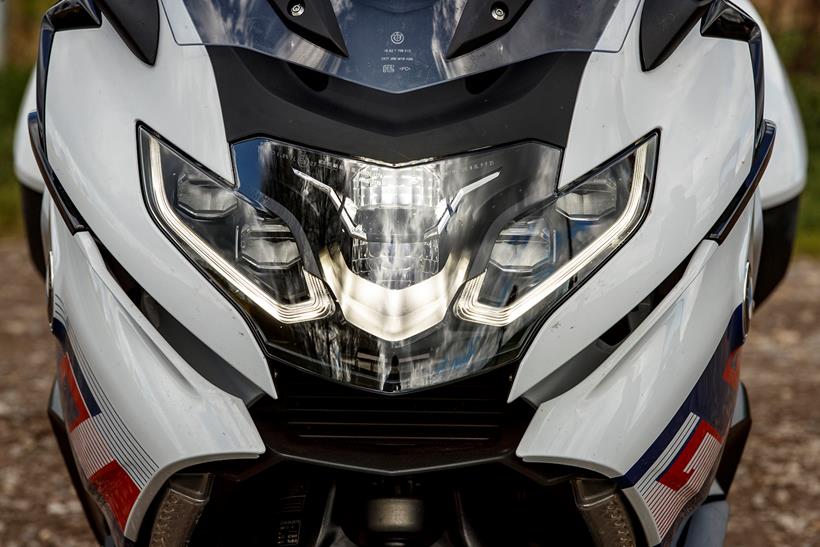
The weighting game
Holy moly – it’s a biggun. Tipping the scales at 343kg (kerb) it’s 100kg heavier than the MultiV4S! It’s inescapable, too. Yes, the K feels light on its toes and surprisingly agile, but swift direction changes, undulating roads and manual handling all bring that weight to bear. Good luck paddling backwards up a mild incline, or on a gravel drive, too. There’s a good reason it has a reverse gear – you need it.
Where’s the radar tech?
Despite being utterly laden with tech and features, there are some flagship elements missing against the competition (and BMW’s own range). Where’s the adaptive radar-enabled cruise control? The RT has it, but the GT doesn’t. Ditto the lack of blind-spot detection. For a bike of this type, and at this price, and considering it’s destined to spend much of its life touring on big roads, it suddenly feels like a glaring omission. It certainly can’t have been left off due to weight concerns.
Contact: richard.newland@motorcyclenews.com
I’ve had a soft spot for the Special K ever since riding on its South Africa launch back in 2011 – but I’ve never had a dedicated tourer in my garage, so this is going to be an interesting test. Will it change how I ride, where I ride, why I ride? Just how good is it at delivering its horizon-shrinking brief? Will I ever use the reverse button? And how/why does it weigh 343kg?! All these questions and more will yield to some – hopefully – serious miles
